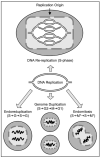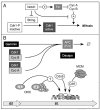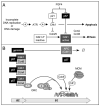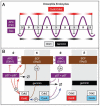Developmentally programmed endoreduplication in animals
- PMID: 19372757
- PMCID: PMC2753833
- DOI: 10.4161/cc.8.10.8325
Developmentally programmed endoreduplication in animals
Abstract
Development of a fertilized egg into an adult human requires trillions of cell divisions, the vast majority of which duplicate their genome once and only once. Nevertheless, trophoblast giant cells and megakaryocytes in mammals circumvent this rule by duplicating their genome multiple times without undergoing cell division, a process generally referred to as 'endoreduplication'. In contrast, arthropods such as Drosophila endoreduplicate their genome in most larval tissues, as well as in many adult tissues. Endoreduplication requires that cells prevent entrance into or completion of mitosis and cytokinesis under conditions that permit assembly of prereplication complexes. In addition, cells must prevent induction of apoptosis in response to incomplete DNA replication or DNA damage that may occur during the ensuing sequence of 'endocycles'. Thus, developmentally regulated endoreduplication results in terminal cell differentiation. Recent progress has revealed both differences and similarities in the mechanisms employed by flies and mammals to change from mitotic cell cycles to 'endocycles'. The critical step, however, appears to be switching from a CDK-dependent form of the anaphase promoting complex (APC) to one that functions only in the absence of CDK activity.
Figures






References
-
- Saxena S, Dutta A. Geminin-Cdt1 balance is critical for genetic stability. Mut Res. 2005;569:111–21. - PubMed
-
- Smith AV, Orr-Weaver TL. The regulation of the cell cycle during Drosophila embryogenesis: the transition to polyteny. Development. 1991;112:997–1008. - PubMed
-
- Cross JC. How to make a placenta: mechanisms of trophoblast cell differentiation in mice—a review. Placenta. 2005;26:3–9. - PubMed
Publication types
MeSH terms
Grants and funding
LinkOut - more resources
Full Text Sources
Other Literature Sources
Molecular Biology Databases
